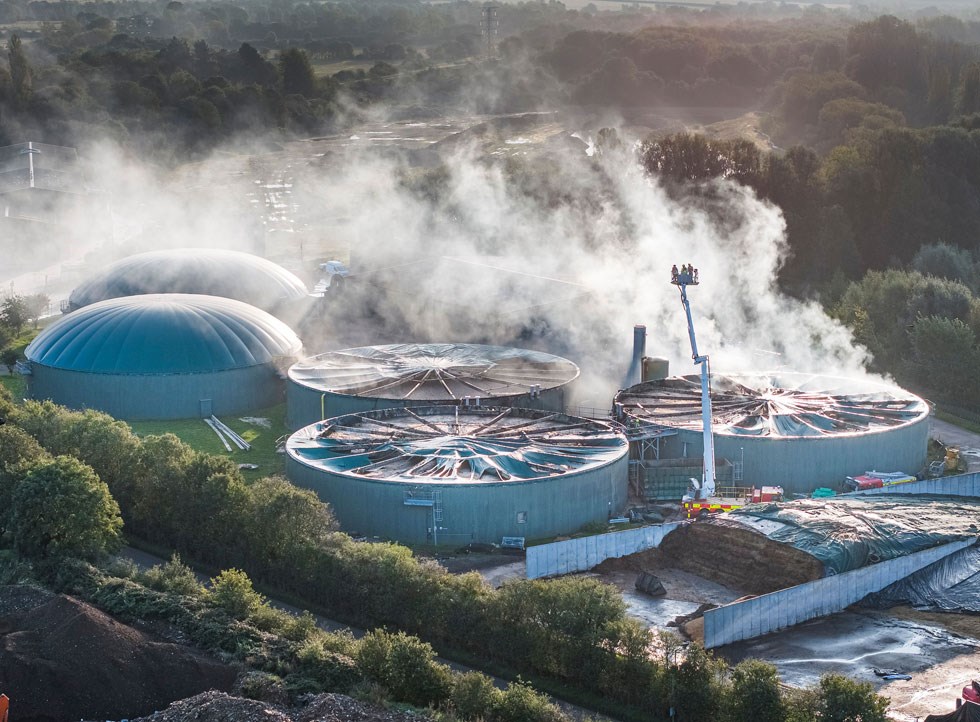Lightning strike destroys biogas tanks at Severn Trent food waste recycling facility

“STANDARDS need to be followed for this very well-known risk,” stressed IChemE Safety Centre director Trish Kerin after lightning struck a biogas tank, causing an explosion and fire at a UK anaerobic digestion facility.
The incident occurred on 2 October at Severn Trent Green Power’s Cassington site near Yarnton, Oxfordshire at around 19:20 local time, reports BBC News. While no casualties or injuries were reported, another BBC article states that the fire damaged three of the site’s five tanks. Rob MacDougall, chief fire officer with Oxfordshire County Council, told BBC Radio Oxford that the plastic coverings on the top of the tanks were “completely destroyed”.
The Cassington anaerobic digestion facility processes commercial food wastes, including packaged goods. Recycling more than 50,000 t/y of solid and liquid waste, it generates 2.1 MW of electricity and produces biofertiliser.
A spokesperson for Severn Trent Green Power said yesterday that the site had been made safe. However, the incident also prompted a temporary, partial closure of the A40. Local residents were advised to stay home and to shut windows and doors, but these restrictions have now been lifted.
According to BBC News, a spokesperson for the UK’s Health and Safety Executive said it was aware of the incident and making enquiries.
Discussing Natechs, natural disasters that trigger technological accidents, Kerin said: “These risks are well known and there are clear standards for the requirements, including testing and maintenance to ensure the electrical charge can dissipate without creating an ignition source.”
She said that Natech accidents need to be understood and risk-assessed, adding: “This event is foreseeable and needs to be taken into account. There can be some lesser-known events, and some events that are not predictable (while still being foreseeable, for example we cannot predict when an earthquake will strike but in certain regions of the world, we know they will occur). We need to ensure for these events that mitigation means are understood and accounted for.”
Lightning defence
Keith Plumb, a consultant on process, safety, and equipment, recommended the European Standard BS EN 1127-1 to help designers consider explosion risks. He noted a line in the standard stating that “if lightning strikes in an explosive atmosphere, ignition will always occur”. “That’s what you have to assume,” he said.
The guidance later discusses requirements for lightning protective measures. It doesn’t offer “absolute mechanical details”, Plumb added. “[But] this would normally be a starting point if you were considering what prevention and protection measures you required. Any designer, certainly in the UK, and I would have said around Europe, would start with this standard.”
He also advised that companies ensure they have access to such standards, also recommending BS EN/IEC 62305, which focuses on lightning protection.
Defending against increasing risk
Safety expert Zsuzsanna Gyenes noted in Issue 292 of IChemE’s Loss Prevention Bulletin (LPB) that lightning strikes are the most common cause of tank fires. And thanks to climate change they, along with other natural disasters, will hit industrial plants, processes, and units more frequently.
While there were no casualties or injuries resulting from the incident at the Cassington site, Gyenes’ article highlights a fatal incident in Cuba last August. Lightning struck a storage tank at an oil depot and the resulting fire killed 14 responding firefighters.
Gyenes said that industrial process units should be designed to be resistant to the impacts of extreme natural hazards, even if that means retrofitting equipment and units that are vulnerable to damage. She added that it will be increasingly necessary to maintain the protection of these assets and to consider additional safety barriers, to prevent lightning strikes and/or mitigate the consequences.
Last year, TCE editor Adam Duckett spoke to Steven Fitzgibbon about reducing the risks from natural hazards as climate change increases their frequency and severity.
Update: This article was updated on 13 October to include statements from Keith Plumb.
Recent Editions
Catch up on the latest news, views and jobs from The Chemical Engineer. Below are the four latest issues. View a wider selection of the archive from within the Magazine section of this site.




